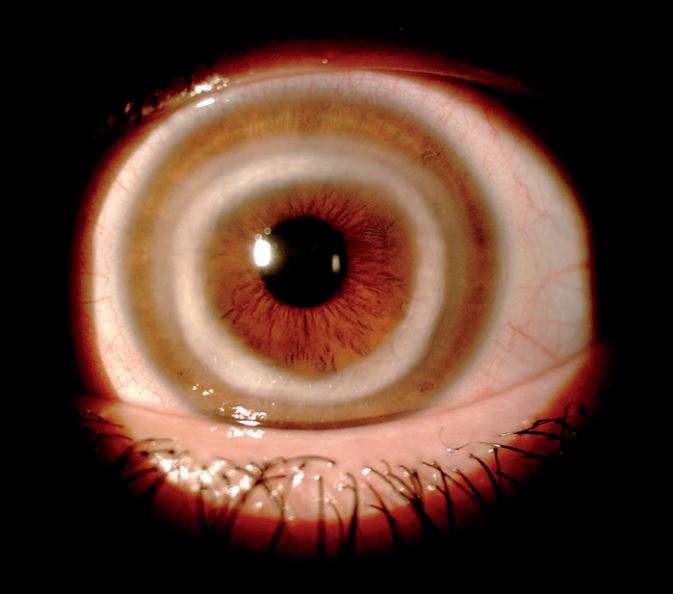What Caused This Eerie White Ring in a Woman's Eye?

It looks like a costume contact lens for Halloween — an eerie white ring in a woman's eye. But this unusual eye problem was the result of a rare autoimmune condition, according to a new report of the woman's case.
The 24-year-old woman in Portugal had a long history of eye problems — for 10 years, she had experienced periods of eye redness and sensitivity to light, according to the report, published yesterday (Feb. 28) in The New England Journal of Medicine. But eventually, her vision troubles sent her to the doctor.
An eye exam revealed inflammation and "crystalline deposits" in part of her cornea, the clear, dome-shaped surface that covers the front of the eyeball, according to the report. Doctors diagnosed her with a condition called interstitial keratitis, which is inflammation in the middle layer of the cornea. ['Eye' Can't Look: 9 Eyeball Injuries That Will Make You Squirm]
The condition is usually caused by an infection, such as from syphilis or herpes simplex virus. But tests for a number of infections came back negative, leaving the doctors puzzled over the cause.
It wasn't until six months later — when the woman started having other symptoms, including vertigo, tinnitus (ringing in the ears) and hearing loss — that doctors were able to pinpoint the ultimate cause of the women's problems. Her constellation of symptoms was the result of a rare autoimmune condition called Cogan's syndrome, according to the report.
Doctors don't know what causes Cogan's syndrome, but they think it may occur when the body's immune system mistakenly attacks tissues in the eyes and ears, according to Harvard Medical School.
Having this type of eye inflammation caused by an immune condition is very uncommon, said Dr. Anat Galor, a clinical spokesperson for the American Academy of Ophthalmology who was not involved with this patient's case.
Sign up for the Live Science daily newsletter now
Get the world’s most fascinating discoveries delivered straight to your inbox.
"It's super-rare to have an autoimmune disease cause" interstitial keratitis, Galor told Live Science. Instead, the condition is almost always caused by an infection, often the herpes simplex virus, she said.
But regardless of what causes the interstitial keratitis, doctors think the eye symptoms result from the body's immune response, either to the infection or to its own tissues, Galor said.
The whitening seen in the cornea can be either edema, or swelling, in the initial stages of the disease, or scarring in the later stages, she said.
The white ring seen in this patient's eye looks different from the typical presentation of interstitial keratitis, Galor noted. Usually, the whitening starts at the limbus, or the border between the cornea and the white part of the eye, and makes its way into the center of the cornea. But in this woman's case, there is clear space between the limbus and the ring-shaped opacity, Galor said.
Galor said she has never seen a case of Cogan's syndrome in her 15 years of practice. But eye doctors always consider it in a case like this, since it can be one of the causes of interstitial keratitis, she said.
Because many conditions and diseases can cause eye symptoms, ophthalmologists can help guide a patient's diagnosis by communicating with the patient's other doctors, and helping to put the full story together, Galor said.
Patients with interstitial keratitis receive treatment for inflammation and for the underlying condition (such as an infection). Sometimes, the condition can lead to permanent scarring and vision problems, Galor said.
In the Portuguese woman's case, she received treatment with glucocorticoids, or steroid hormones that treat inflammation. One month later, the patient saw some improvements in her vision, but she still had mild hearing loss in both ears, the report said.
Original article on Live Science.

Rachael is a Live Science contributor, and was a former channel editor and senior writer for Live Science between 2010 and 2022. She has a master's degree in journalism from New York University's Science, Health and Environmental Reporting Program. She also holds a B.S. in molecular biology and an M.S. in biology from the University of California, San Diego. Her work has appeared in Scienceline, The Washington Post and Scientific American.










